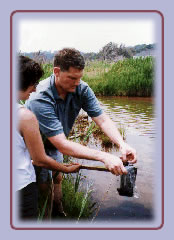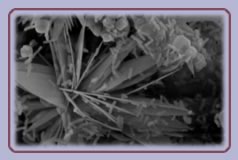:: Environmental Microbiology Research Opportunities ::UMass Microbiology labs study the ecology and physiology of microorganisms in natural environments. We are taking a variety of approaches to critical questions that affect the environment, which affords a number of different research opportunities for students. Dr. Derek LovleyDr. Lovley's research is focused
on the physiology and ecology of novel anaerobic microorganisms. Current
topics of investigation include: microbial metabolism and community
structure in the deep subsurface and hydrothermal zones; evolution of
anaerobic respiration; mechanisms of electron transport to Fe(III) and
humic acids; anaerobic bioremediation of petroleum-contaminated subsurface
and aquatic habitats; and bioremediation of metal contamination. Dr. Susan LeschineThe primary objective of Dr. Leschine's
research is to advance understanding of fundamental aspects of the biology
of polysaccharide-fermenting microorganisms. Vast quantities of plant
polysaccharides such as cellulose and hemicelluloses are present in
anaerobic environments (e.g., in sediments and some soils). Anaerobic
microorganisms that ferment these polymers play a central role in carbon
cycling on the planet as a source of CO2 and indirectly of
CH4. For the most part, the research has concerned species
of Clostridium isolated from a variety of soils collected from
locations around the world. Many of these clostridia produce
ethanol as a product of cellulose fermentation and, therefore, are potentially
useful for producing fuel alcohol from biomass. Present investigations
are directed towards understanding the physiology and ecology of these
bacteria and the cellulase enzymes they produce. Systems of genetic
exchange are being developed for these bacteria to improve ethanol production
through genetic manipulations. An important aspect of the work concerns
studies of the enzyme systems that catalyze the degradation of plant
polymers. Bacteria attack these insoluble substrates by releasing degradative
enzymes into their environment. For the most part, anaerobic bacteria
produce extracellular high-molecular-weight multiprotein complexes that
catalyze the hydrolysis of cellulose and other components of plant cell
walls such as xylan. Recent research in this laboratory has shown that
the cellulase systems of anaerobes may be composed of several discrete
multiprotein complexes, rather than a single complex as had been thought
previously. Current research is aimed at characterizing the enzyme complexes
produced by a species of Clostridium and exploring the possibility
that one component (a glycoprotein and the only component common to
all complexes) may act as a "scaffolding" protein in the extracellular
assembly of this complex enzyme system. More
information and recent publications. Dr. Steve Goodwin
Dr. Goodwin's research interests
include the study of interspecies hydrogen transfer. The transfer of
hydrogen between microorganisms is known to be crucial to the efficient
flow of both carbon and electrons during anaerobic digestion. Field
and laboratory techniques have been used to study the bioenergetics
and kinetics of hydrogen transfer in methanogenic environments including
acid peat bogs and manure slurry pits. Other studies have examined the
potential of ferric iron to serve as a terminal electron acceptor during
bioremediation of anaerobic aquifers. Basic studies of the anaerobic
metabolism in the dissimilatory iron-reducing isolate Geobacter metallireducens
have been completed. Currently the biochemical pathways for the degradation
of toluene and p-cresol are being studied in this organism. A third
area of research is the potential for microbially produced polyesters
to serve as biodegradable plastics. The focus has been on the microbial
storage products such as poly(b-hydroxybutyrate-co-b-hydroxyvalerate)
and poly(b-hydroxyoctanoate). In addition,
the biodegradability of some synthetic polyesters such as polycaprolactone
and polylactide have been investigated. Many of these polyesters have
proven to be readily degradable in marine, freshwater, soil, and compost
environments. The bacterial and fungal isolates responsible for this
degradation have been shown to produce a variety highly of specific,
extracellular depolymerases. The production of these depolymerases is
tightly regulated based on substrate availability and environmental
growth conditions. In addition to their applicability to solid waste
disposal problems, these systems constitute additional models for extracellular
polymer degradation and provide interesting comparisons with other well
studied systems such as those responsible for cellulose degradation.
Current investigations are exploring the ecological role of these microbial
storage products in marine microbial mat ecosystems. More
information and recent publications. |
|
|
Department
of Microbiology
|
|
|
 These
studies are being approached at the genetic, biochemical, and ecological
level. Examples of recent activities include the sequencing of the genome
of Geobacter sulfurreducens, biochemical studies on Fe(III) reductases
in dissimilatory Fe(III)-reducing microorganisms; molecular studies
of the microbial communities in metal- and organic-contaminated aquifers;
and collaboration with industry to apply a novel bioremediation strategy
to a petroleum-contaminated aquifer.
These
studies are being approached at the genetic, biochemical, and ecological
level. Examples of recent activities include the sequencing of the genome
of Geobacter sulfurreducens, biochemical studies on Fe(III) reductases
in dissimilatory Fe(III)-reducing microorganisms; molecular studies
of the microbial communities in metal- and organic-contaminated aquifers;
and collaboration with industry to apply a novel bioremediation strategy
to a petroleum-contaminated aquifer. 

